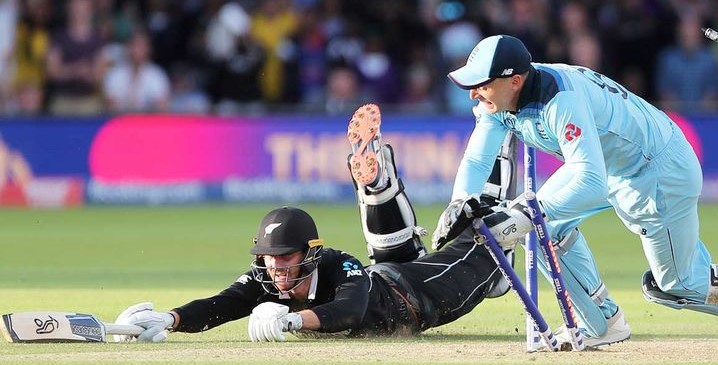Test Match Therapy: Introduction
0By Euan McCabe
I’ve got a message for those people who say the ICC World Test Championship is flawed; has no history or merit; may not have a future; has a format which produced the wrong finalists; was corrupted by Covid-19 interference; was corrupted by ICC interference; that the final should have been played as a series rather than a one-off match; that the final should not have been be played at a neutral venue; that a sixth day should not have been added to the final; that New Zealand weren’t good enough to be in the final; that conditions in Southampton suited New Zealand too much; that winning the toss was the difference; that India would thrash New Zealand in India; or that Australia did thrash New Zealand in Australia.
It’s quite a simple message: Piss off. Because when somebody breaks into your house in the early hours of a cold July morning and steals the ICC World Cup from your lounge on the flimsy notion of fewer boundaries scored, you no longer care about rules, theories, semantics, guilt, merit or luck.
What irritated me most about the events of that ghastly day at Lords was a realisation that I was now destined to die without New Zealand’s name being on the ICC World Cup. Half a century of intense, often tortured support and six failed semi-final attempts had at least flirted with hope in 2015 as Grant Elliott’s shot kept climbing up through the Auckland night. It was not to be, however – mauled in the MCG final by Australia and its unique brand of undignified aplomb.
But the Lords final of 2019 had felt different.
First, it arrived so quickly after the previous long-awaited one, and so unexpectedly. Like London buses.
Second, this time an unfancied New Zealand side had cleverly manoeuvred an unnoticed side-door entrance into the final that had come in stark contrast to the hometown fanfare of four years previously.
And third, England appeared beatable. Sure, England was a good side and playing at home but, in a somewhat ironic twist, the slow and sticky Lords pitch appeared more suited to New Zealand’s style as opposed to England’s more aggressive approach – which, just to add further irony and confusion, had been lifted directly from the Black Caps own BMac 2015 Model.
To not lose a final and then have nothing to show for it is one of the stranger quirks of sport. And it comes with little to recommend it. Tied matches are so rare in cricket that you wonder why such a peerless outcome in a World Cup final could not have been celebrated instead of being hurriedly driven out of town. And besides, a shared trophy would have meant New Zealand’s name was on it. At last. And for evermore.
That was the worst aspect of Lords 2019 for me. Not the game itself, the circumstances, Trent Boult’s heel, the deflection, the Super Over, the final outcome, even that England got to be called World Champion. They were all terrible. But what made it so much more unbearable for me was the realisation that a third bus would never arrive. We were blessed with two. And we missed both: the second by a margin so agonising that you actually wished it had neer turned up in the first place.
To those people who could sense my pain in the aftermath, I thank you for your words of support and encouragement. But “There is always next time” is a cliché that should have been avoided. It just made me angrier. Because this is not rugby or netball. It is cricket. And in cricket New Zealand is a minnow; and when you are a minnow, a talented team and a shitload of really challenging achievements, perfect timing and good luck all have to come together at the same time for you to end up a World Champion. Including, as it turns out, the number of boundaries hit in a final.
The 2019 ICC World Cup final left me trapped in a state of purgatory for the rest of my life. Every Black Cap win in any format of the game from this point onwards would be sullied by the thought of what happened at Lords and be an endless reminder of our one great missed opportunity. There would be no more World Cup finals. No chance for redemption. The moment was lost, gone forever.
One thing I felt certain about was that the ICC’s newly-minted World Test Championship was unlikely to provide any salvation. Not only did it appear clunky and unworkable but it also seemed to belong to somebody else: Those countries which play twice as much Test cricket as we do. We had a good Test side – in fact, one of the best in our history – but we also had an administrative body and international opponents who treated New Zealand Test cricket as little more than a box which had to be ticked. And then there was the Australian tour of 2019-20, when our shortcomings were brutally magnified by a genuine title contender.
On 1 December last year, two days before New Zealand’s 2020-21 home Test programme commenced, I read an article written by Stuff’s Mark Geenty explaining what had to happen in order for New Zealand to qualify for the WTC final. I hope Geenty won some kind of award for this column, because seldom has so much complexity been successfully crushed into a readable format. But the outlook for New Zealand from Geenty’s permutations was not great: Pretty much zero chance. Not that I cared that much. It’s hard to lose interest in something you were never interested in.
203 days later Kane Williamson lifted the WCT Mace at Southampton. Quite how this occurred is beyond me because I regard it a miracle, and miracles have no explanation. A third bus did arrive after all; “There is always next time” proved a perfectly valid cliché; while a talented team and a shitload of really challenging achievements, perfect timing and luck all came together at the same time for us to end up as World Champion. Miraculous.
Nw Zealand are the World Champions of Test cricket.
Need to type that again. Only bigger this time:
NEW ZEALAND ARE THE WORLD CHAMPIONS OF TEST CRICKET.
And our name is on the trophy. For evermore.
New Zealand’s victory in Southampton meant a sudden and unexpected release from my lifetime purgatory. Now I can now simply relax and enjoy my final session as the light gradually fades around me. Because New Zealand cricket finally made it to the summit after 179 years of trying and I lived to see the day. And it does not matter that one day we will no longer be at summit, because we made it there once. Check the trophy.
The afterglow of Southampton has also allowed me the opportunity to reflect on my lifetime of following cricket in this country.
The first time I became aware of a New Zealand national cricket team was on the evening of Wednesday, March 13, 1974 when our home-delivered copy of the Evening Post newspaper loudly declared on its front page that New Zealand had beaten Australia in a cricket test for the first time. I knew nothing of the history or backstory, but the prominent placement and large bold type indicated that something very special had occurred that day.
I have since devoured the history and the backstory in some depth and came to the conclusion some time ago that cricket in this country never really stood a chance. Domestic isolation, international isolation, fickle weather, poor pitches, poor umpiring, poor coaching, meagre finances, amateur and belligerent administration, daft selections, a small player base, a weak and truncated domestic programme, and a lack of consistent exposure to international quality cricket all resulted in a struggling start that eventually morphed into more than a century of underachievement. Not to mention embarrassment. And the demographics did not help either: Farmers, forestry workers and miners make great rugby players, but such physical occupations tend not to produce the same quantity of great cricketers. When those first All Black sides were conquering Britain, our cricketers were back at home pitting 22 players against the 11 of sponsored touring sides from Australia and England and still being heavily beaten.
The 1974 victory against Australia in Christchurch was regarded as the first time New Zealand had won a Test against a ‘major’ cricketing nation and was undoubtedly a watershed moment. It came at almost exactly the halfway point of our 91 years of Test cricket history. It was New Zealand’s 113th Test and just the eighth win. The WTC final in Southampton was New Zealand’s 445th Test and its 107th win. As the Americans would say, do the math.
I have followed all 332 Tests since that famous day at Lancaster Park in 1974, which equates to a considerable amount of punishment. But the many trials and tribulations no longer seem quite as draining given our new recently-acquired status as World Test Champion (yes, that’s right, you are not misreading – New Zealand is World Test Champion). In fact, you could even argue that they all helped make it possible.
As a supporter, Southampton certainly made the decades of hardship seem so much more bearable, even to the point where I now feel it is safe to write about them. It will act as a form of much-needed therapy. So over the next few months, as spring starts to appear and the smell of mud is replaced by that glorious smell of freshly mown pitches, I will be writing a series of articles about my 47 year relationship with Test cricket in this country. There will be those games that stopped the nation; the most memorable series; the finest individual performances; my personal favourites; the greatest escapes; the most irritating, exasperating and insufferable; and – it wouldn’t be New Zealand without – the most excruciating run chases.
I hope you will enjoy them. And I look forward to any feedback. While these will be personal choices as seen through my own lens at the time, there may well be disagreement or differing opinions about certain games, performances or rankings. Which is fine.
And lastly, apologies in advance to those too young to remember the 1980’s but this will be a decade which features regularly. Aside from being a period in human evolution when taste in just about everything was so appalling that the decade eventually just gave up and chundered on itself, it was a critical ten years in terms of the maturing of New Zealand Test cricket. Some people say it was dull cricket in comparison to today’s Black Caps. And they could well be right. But it was also when our cricketers finally reached the North Face of Everest and every step towards the top then had to be painstakingly chiselled out of rock.
Follow Euan on Twitter

